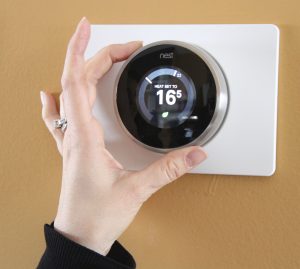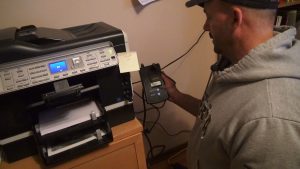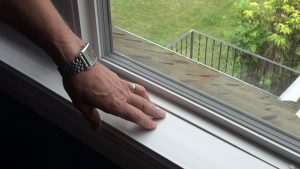By David Dodge and Scott Rollans
Here at Green Energy Futures, we love nothing better than to explore the latest high-tech, net-zero homes that are springing up throughout our province.
The new EnerGuide label explained
But, most of us live in ordinary, older homes. We’ve looked at some of the radical steps you can take to transform a typical home—taking it to net zero, for example, or installing large solar-power arrays. In this story, we look at both of the modest and extensive ways you can improve your home’s efficiency—small and big steps that can add up to big savings, and a significantly reduced carbon footprint.
To assemble our list of top ten actions you can take, we accompanied EnerGuide for homes auditor Jeff Paton as he conducted an EnerGuide assessment of Brian and Laura Finley’s 1956 home in Edmonton, Alberta. Then we pushed beyond the EnerGuide assessment and put together this list of the top 10 ways to improve the energy efficiency of your home.
Top 10 Energy Efficiency tips for your home
- 1. Conduct a home energy assessment
EnerGuide info report for Finley homeTo save energy in your home, it helps to understand how you’re currently consuming—and possibly wasting—heat and electricity. A professional home energy assessment will provide comprehensive data on your home energy use, and help provide a road map for improvements. The investment—$500-750, depending on the size of your home—will pay off in the long run. Some municipalities (like Edmonton) offer rebates to help cover the cost. You can also self-audit your home as well, like Rob Kube did in our story The Energy Detective. The trick is to understand real data, so your improvements actually make a difference.
2. Insulate!
In a cold climate like Alberta’s, home heating accounts for about 63 per cent of your total energy costs. So, if you’re losing heat, you’re effectively burning money. Cold walls, uneven heat, and high indoor temperatures in the summer are all signs of a poorly insulated home. In older homes, attics and unfinished basements are an easy place to start—simply add insulation. Then, move on to tackle the other areas. Depending on the scale of your insulating job, you may qualify for up to $3,500 in current Energy Efficiency Alberta rebates. Insulation is the secret of the new net-zero homes.
- 3. Seal the envelope
If your house is leaking air, it’s also leaking energy. A home energy assessment can measure and identify the key problem areas, but basic improvements can begin with a caulking gun, to seal gaps and cracks, and weatherstripping, to prevent drafts around doors and windows. If you get an EnerGuide assessment, they will depressurize your home and use an infrared camera to literally see where cold air is seeping into your home. This can be significant in older homes. A 50 year old home has close to 10 air changes per hour; a new home built to code will have about 2.5 air changes per hour. Net-zero homes typically have less than one air change per hour, plus air exchangers that recover 65 per cent of the heat from exhaust air.
4. Upgrade your windows
Windows represent a big investment, and a long-term payback, but they’re a key element in any energy-efficient home. As a bonus, better windows will also reduce noise from outdoors. Look for triple-glazed windows with ENERGY STAR® High Efficiency rating and be sure to check for rebates in your area.
5. Install a high-efficiency furnace
Until fairly recently, furnaces were inefficient. A 20-year-old home, for example, may have a 77 per cent efficient furnace in it. Many newer furnaces operate at 97 per cent efficiency—saving you more than 20 per cent in heating costs over the life of the furnace. As usual, pay attention to Energuide ratings and ENERGY STAR®. Super-efficient solar-powered net-zero homes use electric heat-pump furnaces, which are 250 per cent efficient.
6. Use a smart thermostat
 You can spend less on heating simply by heating less. With a smart thermostat, you can reduce the temperature in your home at preset times—for example, dropping the setting to 15 degrees C at night, or during weekdays when the house is empty. Smart thermostats are very easy to set up—automatically learning how you use your home, and reducing heat when it’s appropriate. Most smart thermostats are also Wi-Fi-connected, allowing you to control them even when you’re away from home. They’re simpler to use, but (not surprisingly) cost more. Rebates are offered in some jurisdictions.
You can spend less on heating simply by heating less. With a smart thermostat, you can reduce the temperature in your home at preset times—for example, dropping the setting to 15 degrees C at night, or during weekdays when the house is empty. Smart thermostats are very easy to set up—automatically learning how you use your home, and reducing heat when it’s appropriate. Most smart thermostats are also Wi-Fi-connected, allowing you to control them even when you’re away from home. They’re simpler to use, but (not surprisingly) cost more. Rebates are offered in some jurisdictions.
7. Tame your appliances
Your clothes dryer, even if it’s new, is likely your home’s biggest electricity hog. Consider partially drying your clothes and then hanging them to dry the rest of the way (similarly, let your dishes air-dry instead of running your dishwasher’s drying cycle). Other home appliances have improved dramatically over the years. For example, a fridge from the 1970s may chew through 1,750 kWh/year, whereas a modern fridge with an icemaker uses 500 kWh/year or less. Energy Efficiency Alberta currently offers rebates up to $100 on refrigerators and washers. Induction stoves and cooktops are another energy-saver we really like—superior appliances that consume roughly half the electricity of conventional stoves while heating many foods much more quickly.
8. Water heating
Check out the three most energy efficient water heaters in our story Hot Water Heaters 101. The energy used to heat water can account for a whopping one-fifth of your total home energy costs. Old water heaters are about 60 per cent efficient, whereas high-efficiency tank-based water heaters can now reach 90 per cent efficiency. Tankless water heaters are 97-98 per cent efficient, and have made great strides in user satisfaction. Even better, tankless heaters currently qualify for Energy Efficiency Alberta rebates of up to $944. Hybrid heat-pump water heaters run on electricity (great for net-zero homes) and are 330 per cent efficient.Upgrading from a conventional to a tankless 97 per cent efficient model will save up to 37 per cent on water heating.
9. Light smarter
This is your simplest fix, and will pay for itself in practically no time. Many homes still use incandescent bulbs, despite the technical advances and increased affordability of LEDs. An LED bulb uses roughly 25 per cent the electricity of an incandescent bulb, and generally has a drastically greater lifespan—paying for itself multiple times. In places where you use multiple bulbs (decorative fixtures, pot lighting) the savings add up that much more quickly. Efficiency Alberta regularly offers instant rebates on LED bulbs, but they’re a brilliant investment even at regular price. In our Energy Detective story Ron Kube replaced 80 bulbs in his home and reduced electricity use for lighting five-fold!
10. Be a ghostbuster
 Countless electronic devices—TVs, PVRs, computers, printers, phone chargers, etc.—draw power even when they’re not being used—energy efficiency experts call this “phantom power.” Exorcise these demons by unplugging chargers when they’re not being used, or using power bars with single on-off switches. Newer “smart” power bars will actually shut off a circuit if it senses that a device is not in active use. In our Energy Detective story we found seven per cent of Ron Kube’s home electricity use was by phantom power.
Countless electronic devices—TVs, PVRs, computers, printers, phone chargers, etc.—draw power even when they’re not being used—energy efficiency experts call this “phantom power.” Exorcise these demons by unplugging chargers when they’re not being used, or using power bars with single on-off switches. Newer “smart” power bars will actually shut off a circuit if it senses that a device is not in active use. In our Energy Detective story we found seven per cent of Ron Kube’s home electricity use was by phantom power.
Thanks to Jeff Paton for helping us put this list together after a tour of the Finley home in Edmonton. Some older homes may require more expensive upgrades to fix big problems, but many homes have many opportunities for energy saving. Take your inventory and then begin investing in the best bets for big returns. We have seen homes that have cut their heating bill in half simply by improving their furnaces and adding smart thermostats, and we have seen other homes where changing lights to LEDs, uplugging an old beer fridge and slaying your phantom power vampires likewise reduced electricity use by half.



